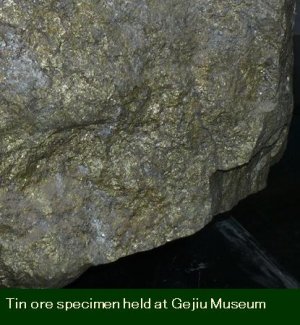Tin 锡 (also 响锡)

Tin evidently is an ancient metal, as it is essential for making tin bronze. Written records document the existence of tin mining in the region for the Han period (Hanshu, see Yang Shouchuan 2014, 13-15). The only specific mine name appears in Xu Bowu zhi 续博物志, a late 10th century compilation, which records a “tin mountain” at the Nuodan river: “诺赕川有锡山.” The area has been identified as the Huili 会理 region in Western Sichuan 四川 and the specific site might be the Lixi 黎溪 mines (Yang Shouchuan 2014, 45-46). Several further mines certainly existed, but the sites have not been identified. Several place names in the Dali and Chuxiong regions also suggest tin mining, but the sites of exploitation are unknown.
In the later Ming period, Gejiu 个旧 appears as a highly important tin and silver mine. As archaeological finds firmly document copper exploitation on the site for the Han 汉 period and tin was worked on an industrial scale from the late 19th century on, partly from surface deposits. Long-standing tin exploitation at Gejiu is highly probable. At the same time, however, the mines were recorded mainly as copper and silver mines during the Qing 清 period. And this dynasty procured tin for the imperial mints from Guangdong 广东, not from Yunnan 云南.
Tin smelting technologies are recorded in Tiangong kaiwu 天工开物. By a strange coincidence, we have descriptions of tin mines on the Bangka islands in Malaysia, which were operated by Hakka from Guangdong certainly since the mid-18th century and possibly earlier (Somers Heidhues 1992). The home region of these migrants was northern inland Guangdong, an old mining region.
Smelting technologies of the Southwest are recorded in some detail only for 20th-century Gejiu, and reconstructions of traditional and historic Chinese tin technologies rely on these records (e.g. Su Rujiang 1942).
Research questions
For reasons of work economy, tin is not a main focus of this research project. We try to cover tin mines in fieldwork when this is feasible, and thus to contribute to the identification of sites.

